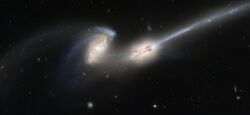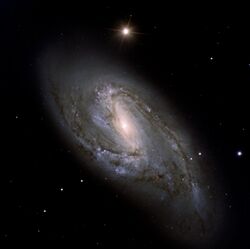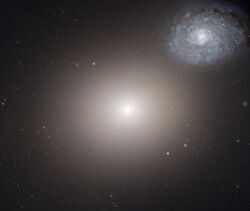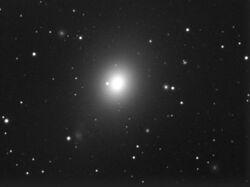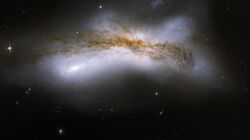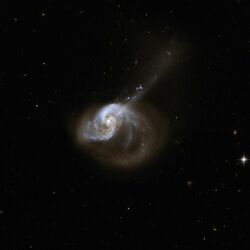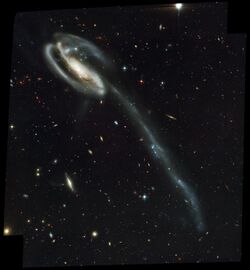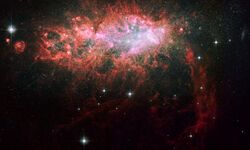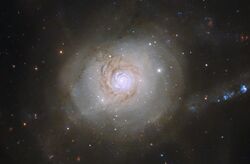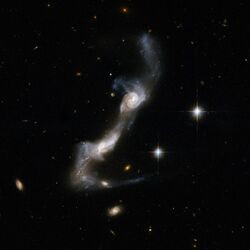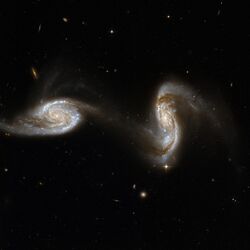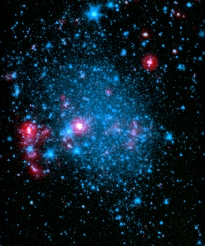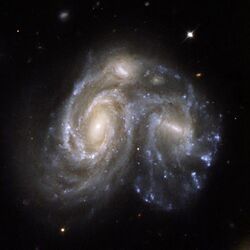Atlas of Peculiar Galaxies
Topic: Astronomy
 From HandWiki - Reading time: 23 min
From HandWiki - Reading time: 23 min
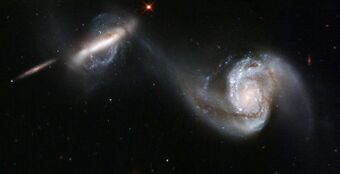


The Atlas of Peculiar Galaxies is a catalog of peculiar galaxies produced by Halton Arp in 1966. A total of 338 galaxies are presented in the atlas, which was originally published in 1966 by the California Institute of Technology. The primary goal of the catalog was to present photographs of examples of the different kinds of peculiar structures found among galaxies.[1]
Background
Arp realized that the reason why galaxies formed into spiral or elliptical shapes was not well understood. He perceived peculiar galaxies as small "experiments" that astronomers could use to understand the physical processes that distort spiral or elliptical galaxies. With this atlas, astronomers had a sample of peculiar galaxies that they could study in more detail. The atlas does not present a complete overview of every peculiar galaxy in the sky but instead provides examples of the different phenomena as observed in nearby galaxies.
Because little was known at the time of publication about the physical processes that caused the different shapes, the galaxies in the atlas are sorted based on their appearance. Objects 1–101 are individual peculiar spiral galaxies or spiral galaxies that apparently have small companions. Objects 102–145 are elliptical and elliptical-like galaxies. Individual or groups of galaxies with neither elliptical nor spiral shapes are listed as objects 146–268. Objects 269–327 are double galaxies. Finally, objects that simply do not fit into any of the above categories are listed as objects 332–338. Most objects are best known by their other designations, but a few galaxies are best known by their Arp numbers (such as Arp 220).
Today, the physical processes that lead to the peculiarities seen in the Arp atlas are thought to be well understood. A large number of the objects have been interpreted as interacting galaxies, including M51 (Arp 85), Arp 220, and the Antennae Galaxies (NGC 4038/NGC 4039, or Arp 244). A few of the galaxies are simply dwarf galaxies that do not have enough mass to produce enough gravity to allow the galaxies to form any cohesive structure. NGC 1569 (Arp 210) is an example of one of the dwarf galaxies in the atlas. A few other galaxies are radio galaxies. These objects contain active galactic nuclei that produce powerful jets of gas called radio jets. The atlas includes the nearby radio galaxies M87 (Arp 152) and Centaurus A (Arp 153).
The peculiar associations present in the catalogue are now interpreted as galaxy mergers or non-interacting line-of-sight overlap, though Arp disputed that idea, claiming that apparent associations were examples of ejections.[2]
Notable Arp galaxies
| Arp Number | Name | Magnitude | Notes |
|---|---|---|---|
| 26 | Pinwheel Galaxy (M101) | +7.5 | spiral galaxy |
| 37 | Messier 77 | +8.9 | radio galaxy |
| 41 | NGC 1232 | +9.8 | spiral galaxy |
| 76 | Messier 90 | +9.5 | spiral galaxy |
| 77 | NGC 1097 | +9.5 | galaxy interacting with its satellite |
| 85 | Whirlpool Galaxy (M51) | +8.4 | galaxy interacting with its satellite |
| 116 | Messier 60 | +8.8 | colliding galaxies |
| 152 | Virgo A (M87) | +8.6 | elliptical galaxy |
| 153 | Centaurus A (NGC 5128) | +6.6 | radio galaxy in a collision? |
| 188 | Tadpole Galaxy | +14.4 | galaxy finishing merging |
| 242 | Mice Galaxies | +14.7 | colliding galaxies |
| 244 | Antennae Galaxies | +10.3 | colliding galaxies |
| 317 | Messier 65 | +9.2 | spiral galaxy |
| 319 | NGC 7320 | +15 | galaxy in colliding group |
| 337 | Cigar Galaxy (M82) | +8.6 | starburst galaxy |
Catalog list
Spiral galaxies
Low surface brightness
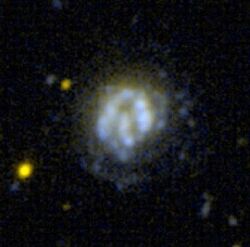
These are mostly dwarf galaxies or poorly defined spiral galaxies (with the designation Sm) that have low surface brightnesses (i.e. they emit little light per unit area). Low surface brightness galaxies are actually quite common. The exception is NGC 2857 (Arp 1), which is an Sc spiral galaxy (which means that it has a definite structure with loosely wound spiral arms and a faint but well-defined nucleus).[3]
| Arp number | Common name | Notes |
|---|---|---|
| 1 | NGC 2857 | Sc spiral galaxy[3] |
| 2 | UGC 10310 | |
| 3 | Arp 3 | |
| 4 | Arp 4 | |
| 5 | NGC 3664 | |
| 6 | NGC 2537 |
Split arms
This category contains spiral galaxies with arms that split into two separate parts.
| Arp number | Common name | Notes |
|---|---|---|
| 7 | Arp 7 | |
| 8 | NGC 497 | |
| 9 | NGC 2523 | |
| 10 | UGC 1775 | Contains an off-center nucleus |
| 11 | UGC 717 | |
| 12 | NGC 2608 |
Detached segments
This category contains spiral galaxies with arms that appear to be segmented. Some spiral arm segments may appear detached because dust lanes in the spiral arms obscure the arms' starlight. Other spiral arms may appear segmented because of the presence of bright star clusters (or discontinuous chains of bright star clusters) in the spiral arms.
| Arp number | Common name | Notes |
|---|---|---|
| 13 | NGC 7448 | |
| 14 | NGC 7314 | |
| 15 | NGC 7393 | |
| 16 | M66 | |
| 17 | UGC 3972 | |
| 18 | NGC 4088 |
Three-armed
Usually, most spiral galaxies contain two clearly defined spiral arms, or they contain only fuzzy filamentary spiral structures. Galaxies with three well-defined spiral arms are rare.
| Arp number | Common name | Notes |
|---|---|---|
| 19 | NGC 145 | |
| 20 | UGC 3014 | |
| 21 | Arp 21 |
One-armed
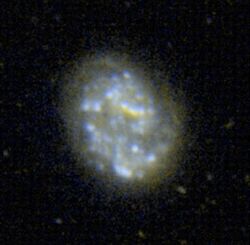
One-armed spiral galaxies, including Magellanic spirals, are also rare. In this case, the single spiral arm may actually be formed by a gravitational interaction with another galaxy (as with the Large Magellanic Cloud itself, although it is not a member of the catalog).
| Arp number | Common name | Notes |
|---|---|---|
| 22 | NGC 4027 | |
| 23 | NGC 4618 | Interacting with NGC 4625[4] |
| 24 | NGC 3445 |
One heavy arm
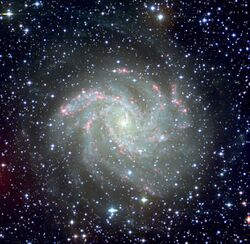
The spiral arms in these galaxies have an asymmetric appearance. One spiral arm may appear to be considerably brighter than the other. In the photographic plates produced by Arp, the bright arm would look dark or "heavy". While most of these galaxies (such as M101 and NGC 6946) are simply asymmetric spiral galaxies, NGC 6365 is an interacting pair of galaxies where one of the two galaxies is viewed edge-on and just happens to lie where the spiral arm for the other face-on galaxy would be visible.[5]
| Arp number | Common name | Notes |
|---|---|---|
| 25 | NGC 2276 | |
| 26 | M101 | Face-on spiral galaxy with five notable companion galaxies[4] |
| 27 | NGC 3631 | |
| 28 | NGC 7678 | |
| 29 | NGC 6946 | |
| 30 | NGC 6365 | Interacting pair of galaxies, with one galaxy viewed edge-on[5] |
Integral sign
These are galaxies that look like a stretched-out S shape (or like the integral sign used in calculus). Some objects, such as IC 167,[6] are simply ordinary spiral galaxies viewed from an unusual angle. Other objects, such as UGC 10770, are interacting pairs of galaxies with tidal tails that look similar to spiral arms.[7]
| Arp number | Common name | Notes |
|---|---|---|
| 31 | IC 167 | |
| 32 | UGC 10770 | |
| 33 | UGC 8613 | |
| 34 | NGC 4615 | |
| 35 | UGC 212 | |
| 36 | UGC 8548 |
Low surface brightness companions
Many of these spiral galaxies are probably interacting with the low surface brightness galaxies in the field of view. In some cases, however, it may be difficult to determine whether the companion is physically near the spiral galaxy or whether the companion is a foreground/background source or a source on the edge of the spiral galaxy.
| Arp number | Common name | Notes |
|---|---|---|
| 37 | M77 | |
| 38 | NGC 6412 | |
| 39 | NGC 1347 | |
| 40 | IC 4271 | |
| 41 | NGC 1232 | |
| 42 | NGC 5829 | |
| 43 | IC 607 | |
| 44 | IC 609 | |
| 45 | UGC 9178 | Galaxy triplet[8] |
| 46 | UGC 12665 | |
| 47 | Arp 47 | |
| 48 | Arp 48 |
Small, high surface brightness companions

Again, many of these spiral galaxies are probably interacting with companion galaxies, although some of the identified companion galaxies may be foreground/background sources or even bright star clusters within the individual galaxies.
| Arp number | Common name | Notes |
|---|---|---|
| 49 | NGC 5665 | |
| 50 | IC 1520 | |
| 51 | Arp 51 | |
| 52 | Arp 52 | |
| 53 | NGC 3290 | |
| 54 | Arp 54 | |
| 55 | UGC 4881 | |
| 56 | UGC 1432 | |
| 57 | Arp 57 | |
| 58 | UGC 4457 | |
| 59 | NGC 341 | |
| 60 | Arp 60 | |
| 61 | UGC 3104 | |
| 62 | UGC 6865 | |
| 63 | NGC 2944 | |
| 64 | UGC 9503 | |
| 65 | NGC 90 | |
| 66 | UGC 10396 | |
| 67 | UGC 892 | |
| 68 | NGC 7757 | |
| 69 | NGC 5579 | |
| 70 | UGC 934 | |
| 71 | NGC 6045 | |
| 72 | NGC 5994, NGC 5996 | |
| 73 | IC 1222 | |
| 74 | UGC 1626 | |
| 75 | NGC 702 | |
| 76 | M90 | |
| 77 | NGC 1097 | |
| 78 | NGC 772 |
Large, high surface brightness companions
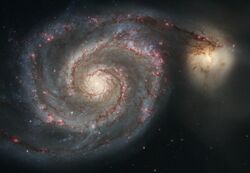
Galaxies in this category are almost always clearly interacting sources. The most famous of these objects is the Whirlpool Galaxy (M51; Arp 85), which is composed of a spiral galaxy NGC 5194 that is interacting with a smaller elliptical galaxy NGC 5195. The interaction has distorted the shape of both galaxies; the spiral arm pattern has been enhanced in the larger spiral galaxy, and a bridge of stars and gas has formed between the two galaxies. Many of the other galaxies in this category are also connected by bridges.
| Arp number | Common name | Notes |
|---|---|---|
| 79 | NGC 5490C | |
| 80 | NGC 2633 | |
| 81 | NGC 6621, UGC 11175, NGC 6622 | |
| 82 | NGC 2535, NGC 2536 | |
| 83 | NGC 3799, NGC 3800 | |
| 84 | NGC 5394, NGC 5395 | |
| 85 | Whirlpool Galaxy (M51) | |
| 86 | NGC 7752, NGC 7753 | |
| 87 | NGC 3808A, NGC 3808B | |
| 88 | Arp 88 | |
| 89 | NGC 2648 | |
| 90 | NGC 5929, NGC 5930 | |
| 91 | NGC 5953, NGC 5954 |
Elliptical companions
Like the spiral galaxies with high surface brightness companions, most of these spiral galaxies are clearly interacting systems. Tidal tails and bridges are visible in many of the images.
| Arp number | Common name | Notes |
|---|---|---|
| 92 | NGC 7603 | |
| 93 | NGC 7284, NGC 7285 | |
| 94 | NGC 3226, NGC 3227 | |
| 95 | IC 4461, IC 4462 | |
| 96 | UGC 3528 | |
| 97 | UGC 7085A | |
| 98 | UGC 1095 | |
| 99 | NGC 7547, NGC 7549, NGC 7550 | Galaxy triplet[9] |
| 100 | IC 18, IC 19 | |
| 101 | UGC 10164, UGC 10169 |
Elliptical and elliptical-like galaxies
Connected to spiral galaxies

These objects are very similar to the spiral galaxies with elliptical companions. All of the galaxies have features such as tidal tails and tidal bridges that have formed through gravitational interaction.
| Arp number | Common name | Notes |
|---|---|---|
| 102 | Arp 102 | |
| 103 | UGC 10586 | Galaxy triplet[10] |
| 104 | NGC 5216, NGC 5218 | |
| 105 | NGC 3561 | |
| 106 | NGC 4211 | |
| 107 | UGC 5984 | |
| 108 | Arp 108 |
Repelling spiral arms
Based on the description of these objects, it appears that Arp originally thought that the elliptical galaxies were pushing away spiral arms in companion galaxies. However, the tidal spiral arms may actually look distorted because of the interaction. Some of these "repelled" spiral arms are on the opposite side of the spiral galaxy from the elliptical galaxy. Simulations have shown that such features can be formed through gravitational interactions alone; no repelling forces are needed.
| Arp number | Common name | Notes |
|---|---|---|
| 109 | UGC 10053 | |
| 110 | Arp 110 | |
| 111 | NGC 5421 | Galaxy group[11] |
| 112 | NGC 7805, NGC 7806 |
Close to and perturbing spiral galaxies
This is another category in which the majority of objects are interacting galaxies. As noted in the category name, the spiral galaxies look perturbed. Arp originally described some of the elliptical galaxies as repelling.
| Arp number | Common name | Notes |
|---|---|---|
| 113 | NGC 70 | Part of a group of galaxies[12] |
| 114 | NGC 2276, NGC 2300 | |
| 115 | UGC 6678 | Galaxy triplet[13] |
| 116 | Messier 60, NGC 4647 | |
| 117 | IC 982, IC 983 | |
| 118 | NGC 1141, NGC 1142 | |
| 119 | Arp 119 | |
| 120 | NGC 4435, NGC 4438 | |
| 121 | Arp 121 | |
| 122 | NGC 6040 | |
| 123 | NGC 1888, NGC 1889 | |
| 124 | NGC 6361 | |
| 125 | UGC 10491 | |
| 126 | UGC 1449 | |
| 127 | NGC 191 | Actually interacting S0 galaxy and spiral galaxy[13] |
| 128 | UGC 827 | |
| 129 | UGC 5146 | |
| 130 | IC 5378 | |
| 131 | Arp 131 | |
| 132 | Arp 132 |
Nearby fragments
| Arp number | Common name | Notes |
|---|---|---|
| 133 | NGC 541 | |
| 134 | Messier 49 | |
| 135 | NGC 1023 | |
| 136 | NGC 5820 |
Emanating material
Arp thought that the elliptical galaxies in this category were ejecting material from their nuclei. Many of the pictures could be interpreted that way. However, these objects are actually a mixture of other phenomena. For example, NGC 2914 (Arp 137) is merely a spiral galaxy with faint spiral arms,[14] and NGC 4015 (Arp 138) is an interacting pair of galaxies where one galaxy is an edge-on spiral galaxy.[15] Some objects, such as NGC 2444 and NGC 2445 (Arp 143), are systems that contain "ring galaxies", which are created when one galaxy (the elliptical galaxies in these examples) passes through the disk of another. This passage causes a gravitational wave in which gas first falls inward and then propagates outward to form the ring structure.[16]
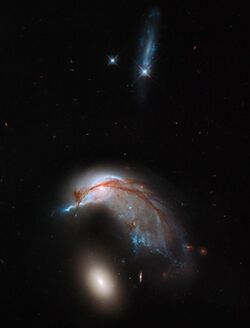
| Arp number | Common name | Notes |
|---|---|---|
| 137 | NGC 2914 | Spiral galaxy with faint spiral arms[14] |
| 138 | NGC 4015 | Interacting pair of galaxies[15] |
| 139 | Arp 139 | Interacting pair of galaxies[18] |
| 140 | NGC 274, NGC 275 | Interacting pair of galaxies[19] |
| 141 | UGC 3730 | Ring galaxy system[20] |
| 142 | NGC 2936, NGC 2937, UGC 5130 | Galaxy triplet[21] |
| 143 | NGC 2444, NGC 2445 | Ring galaxy system[22] |
| 144 | NGC 7828, NGC 7829 | Ring galaxy system[23] |
| 145 | UGC 1840 | Ring galaxy system[24] |
Amorphous galaxies
Galaxies in this category are referred to by Arp as galaxies that are neither spiral nor elliptical in shape. Although he does not use the term "amorphous" to describe these galaxies, it is the best description of these galaxies.
Many of these galaxies are either interacting galaxies or galaxies that are the remnants of the merger of two smaller galaxies. The interaction process will produce various tidal features, such as tidal tails and tidal bridges, that may last well after the progenitor galaxies' disks and nuclei have merged. Although the tidal tails are described as several different visual phenomena ("counter-tails", "filaments", "loops"), they are all manifestations of the same phenomena.
Associated rings
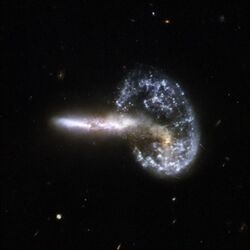
As noted above, these ring galaxies may have formed when a companion galaxy passed through the ring galaxy. The interaction would produce a wave effect that would first draw matter into the center and then cause it to propagate outward in a ring.[16]
| Arp number | Common name | Notes |
|---|---|---|
| 146 | Arp 146 | |
| 147 | IC 298 | |
| 148 | Arp 148 |
Jets
These are galaxies that appear to be ejecting material outwards from their nuclei. The "jets" themselves look similar to water spraying out of a hose. In the case of IC 803 (Arp 149) and NGC 7609 (Arp 150), the jets are simply part of the amorphous structure produced by the interacting galaxies. In Arp 151[citation needed] and Messier 87 (Arp 152), however, the jets are ionized gas that has been ejected from the environment around supermassive black holes in the galaxies' active galactic nuclei.[25][26] These jets, sometimes called relativistic jets or radio jets, are powerful sources of synchrotron radiation, especially at radio wavelengths.
| Arp number | Common name | Notes |
|---|---|---|
| 149 | IC 803 | Interacting galaxies[27] |
| 150 | NGC 7609 | Interacting galaxies[28] |
| 151 | Arp 151 | Seyfert galaxy (contains an active galactic nucleus)[25] |
| 152 | Messier 87 | Seyfert galaxy (contains an active galactic nucleus)[26] |
Interior absorption
Galaxies in this category feature dark dust lanes that obscure part of the disk of the galaxy. All of these galaxies are the products of two galaxies merging. NGC 520 (Arp 157) is one of the best examples of an intermediate-stage merger, where the two progenitor galaxies' disks have coalesced together but the nuclei have not. Centaurus A (Arp 153) and NGC 1316 (Arp 154) are both effectively elliptical galaxies with unusual dust lanes; their kinematics and structure indicate that they have undergone merging events recently. NGC 4747 (Arp 159) may be nothing more than an edge-on spiral galaxy with a significantly dark dust lanes.[29]
| Arp number | Common name | Notes |
|---|---|---|
| 153 | Centaurus A | Notable radio galaxy; contains an active galactic nucleus)[30] |
| 154 | NGC 1316 | Notable radio galaxy; contains an active galactic nucleus)[30] |
| 155 | NGC 3656 | |
| 156 | UGC 5184 | |
| 157 | NGC 520 | Notable intermediate-stage merger |
| 158 | NGC 523 | |
| 159 | NGC 4747 | Spiral galaxy with dark dust lanes[29] |
| 160 | NGC 4194 | Also known as the Medusa Galaxy |
Diffuse filaments
The filaments in these objects may represent tidal tails from galaxy interactions. Many of the galaxies are the remnants of the mergers of two spiral galaxies to form a single elliptical galaxy. However, NGC 3414 (Arp 162) appears to be merely an unusual S0 galaxy with a very small disk relative to its bulge size.[4] NGC 4670 (Arp 163) is a blue compact dwarf galaxy with extremely strong star formation activity;[31] it is clearly too small to be the merger remnant of two spiral galaxies like the other merger remnants in this sample, although it may have been involved in a much smaller interaction.
| Arp number | Common name | Notes |
|---|---|---|
| 161 | UGC 6665 | |
| 162 | NGC 3414 | S0 galaxy[4] |
| 163 | NGC 4670 | Blue compact dwarf galaxy[31] |
| 164 | NGC 455 | |
| 165 | NGC 2418 | |
| 166 | NGC 750, NGC 751 | Interacting galaxies |
Diffuse counter-tails
All of these objects are galaxies involved in gravitational interactions. These counter-tails are tidal features caused by the gravitational interactions between two galaxies, just like similar features described in the Arp catalog. Messier 32 (Arp 168), a dwarf galaxy interacting with the Andromeda Galaxy,[4] is included in this category (although the "diffuse counter-tail" is very difficult to see in Arp's photograph).
| Arp number | Common name | Notes |
|---|---|---|
| 167 | NGC 2672, NGC 2673 | |
| 168 | Messier 32 | Dwarf galaxy interacting with Andromeda Galaxy[4] |
| 169 | NGC 7236, NGC 7237, NGC 7237C | Galaxy triplet[32] |
| 170 | NGC 7578 | |
| 171 | NGC 5718, IC 1042 | |
| 172 | IC 1178, IC 1181 |
Narrow counter-tails
This is another category containing galaxies with tidal tails produced by gravitational interactions. These tidal tails are narrower and better defined than the tidal tails in objects 167–172.
| Arp number | Common name | Notes |
|---|---|---|
| 173 | UGC 9561 | |
| 174 | NGC 3068 | |
| 175 | IC 3481, IC 3481A, IC 3483 | Galaxy triplet[33] |
| 176 | NGC 4933 | Galaxy triplet[34] |
| 177 | Arp 177 | |
| 178 | NGC 5613, NGC 5614, NGC 5615 | Galaxy triplet[35] |
Narrow filaments
This category contains a mixture of different types of objects. Like the galaxies with diffuse filaments or galaxies with counter-tails, some of the galaxies in this category have been involved in interactions, and the filaments are tidal features created by those interactions. Other sources, however, are simply individual spiral galaxies with faint spiral arms that are described as "filaments" by Arp.
| Arp number | Common name | Notes |
|---|---|---|
| 179 | Arp 179 | |
| 180 | Arp 180 | Interacting galaxy pair[36] |
| 181 | NGC 3212, NGC 3215 | Interacting galaxy pair[37] |
| 182 | NGC 7674, NGC 7674A | Interacting galaxy pair[38] |
| 183 | UGC 8560 | Spiral galaxy[39] |
| 184 | NGC 1961 | Spiral galaxy[40] |
| 185 | NGC 6217 | Spiral galaxy[41] |
| 186 | NGC 1614 | Spiral galaxy involved in recent interaction[42] |
| 187 | Arp 187 | |
| 188 | Tadpole Galaxy | Galaxy involved in recent interaction |
| 189 | NGC 4651 | Tidal star streams[43] |
| 190 | UGC 2320 | Interacting galaxy pair[44] |
| 191 | UGC 6175 | Interacting galaxy pair[45] |
| 192 | NGC 3303 | Interacting galaxy pair[46] |
| 193 | IC 883 | Merger remnant |
Material ejected from nuclei

The ejecta in many of these objects appear to be tidal features created by gravitational interactions. In some cases (such as for NGC 5544 and NGC 5545 in Arp 199), the "ejecta" are clearly a spiral galaxy viewed edge-on that happens to line up with another galaxy's nucleus.
Almost all of the objects in this category are interacting or have recently undergone interactions. NGC 3712 (Arp 203) is an exception; it is merely a low surface brightness spiral galaxy.[47]
| Arp number | Common name | Notes |
|---|---|---|
| 194 | UGC 6945 | Interacting galaxy pair[48] |
| 195 | UGC 4653 | Interacting galaxy triplet[49] |
| 196 | Arp 196 | Interacting galaxy pair[50] |
| 197 | UGC 6503, IC 701 | Interacting galaxy pair[51] |
| 198 | UGC 6073 | Interacting galaxy pair[52] |
| 199 | NGC 5544, NGC 5545 | Interacting galaxy pair[53] |
| 200 | NGC 1134 | Spiral galaxy interacting with low surface brightness galaxy[54] |
| 201 | UGC 224 | Interacting galaxy pair[55] |
| 202 | NGC 2719, NGC 2719A | Interacting galaxy pair[56] |
| 203 | NGC 3712 | Low surface brightness spiral galaxy[47] |
| 204 | UGC 8454 | Interacting galaxy pair[57] |
| 205 | NGC 3448 | Merger remnant[58] |
| 206 | UGC 5983, NGC 3432 | Interacting galaxy pair[59] |
| 207 | UGC 5050 | Spiral galaxy interacting with dwarf galaxy[60] |
| 208 | Arp 208 | Interacting galaxy pair[61] |
Irregularities, absorption, and resolution
Galaxies in this category have either irregular structures (irregularities), notable dust lanes (absorption), or a grainy appearance (resolution). This category contains a mix of interacting galaxies distorted by tidal interactions, nearby dwarf irregular galaxies, and spiral galaxies with unusual large amounts of gas.
| Arp number | Common name | Notes |
|---|---|---|
| 209 | NGC 6052 | Interacting galaxy pair[62] |
| 210 | NGC 1569 | Dwarf galaxy[63] |
| 211 | UGCA 290 | Interacting dwarf galaxies[64] |
| 212 | NGC 7625 | Peculiar spiral galaxy[65] |
| 213 | IC 356 | Peculiar spiral galaxy[66] |
| 214 | NGC 3718 | Peculiar spiral galaxy[67] |
Adjacent loops
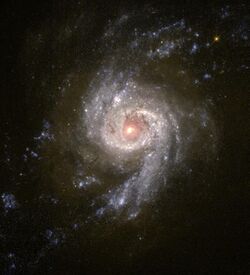
These adjacent loops are another manifestation of the structures formed by gravitational interactions between galaxies. Some of these sources consist of galaxies that have nearly completed the merger process; the "adjacent loops" are merely the remnants of the interaction. Among the objects in this category is Arp 220, one of the best-studied ultraluminous infrared galaxies in the sky.
| Arp number | Common name | Notes |
|---|---|---|
| 215 | NGC 2782 | Peculiar spiral galaxy[4] |
| 216 | NGC 7679, NGC 7682 | Interacting galaxy pair[68] |
| 217 | NGC 3310 | Notable nearby starburst;[69] merger remnant[4] |
| 218 | Arp 218 | Interacting galaxy pair[70] |
| 219 | UGC 2812 | Galaxy in interaction[71] |
| 220 | IC 4553 | Merger remnant; notable ultraluminous infrared galaxy |
Amorphous spiral arms
Many of these galaxies are merger remnants. The "amorphous spiral arms" are the tidal debris that remains after the collision.
| Arp number | Common name | Notes |
|---|---|---|
| 221 | Arp 221 | Interacting galaxy triplet[72] |
| 222 | NGC 7727 | Merger remnant[4] |
| 223 | NGC 7585 | Recent inequal-mass merger[4] |
| 224 | NGC 3921 | Merger remnant |
| 225 | NGC 2655 | Recent inequal-mass merger |
| 226 | The Atoms for Peace Galaxy (NGC 7252) | Merger remnant[4] |
Concentric rings
These are galaxies with shell-like structures. Some shell structures have been identified as the results of recent mergers.[citation needed] In other cases, however, the shell structure may represent the outer disk of an S0 galaxy. In some complicated cases, the galaxy with the rings or shells is an S0 galaxy interacting with another galaxy; the origins of the shells in such systems can be difficult to determine.
| Arp number | Common name | Notes |
|---|---|---|
| 227 | NGC 470, NGC 474 | Interacting galaxy pair with one S0 galaxy[73] |
| 228 | IC 162 | S0 galaxy[74] |
| 229 | NGC 507, NGC 508 | Interacting galaxy pair including one S0 galaxy and one elliptical galaxy[75] |
| 230 | IC 51 | Peculiar S0 galaxy;[76] possible merger remnant |
| 231 | IC 1575 | |
| 232 | NGC 2911 | Peculiar S0 galaxy[77] |
Appearance of fission
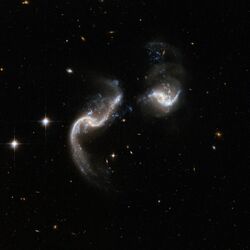
Although the description of the objects in this category implies that the galaxies are separating, most of these galaxies are merging. Many of the objects have very pronounced tidal tails and bridges that have formed as a consequence of the interaction. Most objects are in the early stages of the merging process, where the galaxies still appear to have distinct nuclei and distinct (albeit distorted) disks. Among the most notable galaxies in this category are the Antennae Galaxies (NGC 4038 and NGC 4039, Arp 244) and the Mice Galaxies (NGC 4676, Arp 242).
However, not all of these objects are interacting galaxies. A few of these galaxies are simply nearby dwarf galaxies with irregular structure.
| Arp number | Common name | Notes |
|---|---|---|
| 233 | UGC 5720 | Dwarf galaxy[78] |
| 234 | NGC 3738 | Dwarf galaxy[79] |
| 235 | NGC 14 | Dwarf galaxy[80] |
| 236 | IC 1623 | Interacting galaxy pair[81] |
| 237 | UGC 5044 | Interacting galaxy pair[82] |
| 238 | UGC 8335 | Interacting galaxy pair[83] |
| 239 | NGC 5278, NGC 5279 | Interacting galaxy pair[84] |
| 240 | NGC 5257, NGC 5258 | Interacting galaxy pair[85] |
| 241 | UGC 9425 | Interacting galaxy pair[86] |
| 242 | Mice Galaxies (NGC 4676) | Interacting galaxy pair[87] |
| 243 | NGC 2623 | Interacting galaxy triplet[88] |
| 244 | Antennae Galaxies (NGC 4038, NGC 4039) | Interacting galaxy pair[89] |
| 245 | NGC 2992, NGC 2993 | Interacting galaxy pair[90] |
| 246 | NGC 7837, NGC 7838 | Interacting galaxy pair[91] |
| 247 | UGC 4383 | Interacting galaxy pair[92] |
| 248 | Arp 248 | Interacting galaxy triplet[93] |
| 249 | UGC 12891 | Interacting galaxy pair[94] |
| 250 | Arp 250 | |
| 251 | Arp 251 | Interacting galaxy triplet[95] |
| 252 | Arp 252 | Interacting galaxy pair[96] |
| 253 | UGCA 173, UGCA 174 | Interacting galaxy pair[97] |
| 254 | NGC 5917 | Peculiar spiral galaxy[98] |
| 255 | UGC 5304 | Interacting galaxy pair[99] |
| 256 | Arp 256 | Interacting galaxy pair[100] |
Irregular clumps
These are objects that appear to be a series of irregular clumps with no coherent structure. Many of these objects are simply nearby dwarf galaxies. Some of these objects are interacting galaxies, while others are small groups of galaxies. In both cases, many of the constituent galaxies are irregular galaxies. The superposition of two or more such irregular galaxies can easily look like a single larger irregular galaxy, which is why the Atlas of Peculiar Galaxies (and other catalogs) often classify these pairs and groups as single objects.
| Arp number | Common name | Notes |
|---|---|---|
| 257 | UGC 4638 | Interacting galaxy pair[101] |
| 258 | UGC 2140 | Galaxy group[102] |
| 259 | NGC 1741 | Galaxy group[103] |
| 260 | UGC 7230 | Interacting galaxy pair[104] |
| 261 | Arp 261 | Galaxy group[105] |
| 262 | UGC 12856 | Interacting galaxy pair[106] |
| 263 | NGC 3239 | Dwarf galaxy[107] |
| 264 | NGC 3104 | Dwarf galaxy[108] |
| 265 | IC 3862 | Interacting galaxy pair[109] |
| 266 | NGC 4861 | Dwarf galaxy[110] |
| 267 | UGC 5746 | Dwarf galaxy[111] |
| 268 | UGC 4305, Holmberg II | Dwarf galaxy[112] |
Double and multiple galaxies
Arp originally referred to these galaxies as "double galaxies", but many of these sources are more than two galaxies. Some of the objects consist of interacting galaxies, whereas other sources are actually groups of galaxies. The difference is that interacting galaxies will be distorted, whereas galaxies in groups are simply gravitationally bound to each other but not necessarily close enough to each other to induce major structural changes.
Connected arms
All of these galaxies are interacting pairs of galaxies except for NGC 5679 (Arp 274), which may be an interacting galaxy triplet.[113] The connected arms described here are tidal bridge features that form between interacting galaxies. These bridges form early during galaxy interactions.
| Arp number | Common name | Notes |
|---|---|---|
| 269 | NGC 4485, NGC 4490 | Interacting galaxy pair[114] |
| 270 | NGC 3395, NGC 3396 | Interacting galaxy pair[115] |
| 271 | NGC 5426, NGC 5427 | Interacting galaxy pair[116] |
| 272 | NGC 6050, IC 1179 | Interacting galaxy pair[117] |
| 273 | UGC 1810, UGC 1813 | Interacting galaxy pair[118] |
| 274 | NGC 5679 | Interacting galaxy triplet[113] |
Interacting galaxies
Unlike many of the objects listed in the amorphous galaxies section, the interacting galaxies that comprise these objects are still distinguishable from each other.
| Arp number | Common name | Notes |
|---|---|---|
| 275 | NGC 2881 | Interacting galaxy pair[119] |
| 276 | NGC 935, IC 1801 | Interacting galaxy pair[120] |
| 277 | NGC 4809, NGC 4810 | Interacting galaxy pair[121] |
| 278 | NGC 7253 | Interacting galaxy pair[122] |
| 279 | NGC 1253, NGC 1253A | Interacting galaxy pair[123] |
| 280 | NGC 3769, NGC 3769A | Interacting galaxy pair[124] |
Infall and attraction
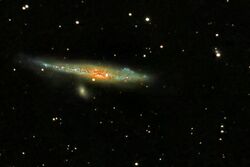
This category contains an odd mixture of objects. Two of the objects are edge-on disk galaxies with smaller companion galaxies nearby. Two of the objects are connected by tidal bridges. The last two objects may simply be interacting with each other over long distance.
| Arp number | Common name | Notes |
|---|---|---|
| 281 | NGC 4627, NGC 4631 | Spiral galaxy with companion dwarf elliptical galaxy[125] |
| 282 | NGC 169, NGC 169A | Spiral galaxy with smaller companion galaxy[126] |
| 283 | NGC 2798, NGC 2799 | Interacting galaxy pair[127] |
| 284 | NGC 7714, NGC 7715 | Interacting galaxy pair[128] |
| 285 | NGC 2854, NGC 2856 | Galaxy pair[129] |
| 286 | NGC 5560, NGC 5566, NGC 5569 | Interacting galaxy triplet[4][130] |
Wind effects
Although included in the double galaxies category, many of these objects are individual galaxies. The "wind effects" refer to the appearance, not the actual detection of high-velocity gas (such as is found in M82). In some cases, the appearance may be the result of interaction. In other cases, particularly NGC 3981 (Arp 289), the faint, extended emission may be related to the intrinsic nature of the galaxy itself and not interactions with other objects.[4]
| Arp number | Common name | Notes |
|---|---|---|
| 287 | NGC 2735, NGC 2735A | Galaxy pair[131] |
| 288 | NGC 5221, NGC 5222 | Galaxy triplet[132] |
| 289 | NGC 3981 | Peculiar spiral galaxy[4][133] |
| 290 | IC 195, IC 196 | Interacting galaxy pair[134] |
| 291 | UGC 5832 | Irregular galaxy[135] |
| 292 | IC 575 | Peculiar spiral galaxy[136] |
| 293 | NGC 6285, NGC 6286 | Interacting galaxy pair[137] |
Long filaments
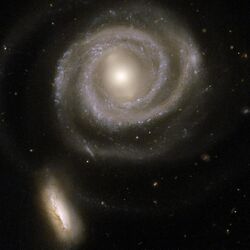
The long filaments in these systems are probably tidal tails or bridges that have been produced as the result of the gravitational interaction between the galaxies.
| Arp number | Common name | Notes |
|---|---|---|
| 294 | NGC 3786, NGC 3788 | Interacting galaxy pair[138] |
| 295 | Arp 295 | Interacting galaxy pair[139] |
| 296 | Arp 296 | |
| 297 | Arp 297 | Interacting galaxies within a galaxy group[140] |
Unclassified objects
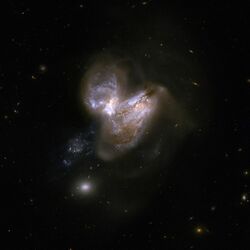

Arp did not give a subclassification for objects 298–310 in his atlas. These objects are mostly interacting galaxy pairs.
| Arp number | Common name | Description |
|---|---|---|
| 298 | NGC 7469, IC 5283 | Galaxy pair[141] |
| 299 | Arp 299 | Galaxy triplet[142] |
| 300 | Arp 300 | Galaxy group[143] |
| 301 | UGC 6204, UGC 6207 | Galaxy pair[144] |
| 302 | UGC 9618 | Galaxy pair[145] |
| 303 | IC 563, IC 564 | Galaxy pair[146] |
| 304 | NGC 1241, NGC 1242 | Galaxy pair[147] |
| 305 | NGC 4016, NGC 4017 | Galaxy pair[148] |
| 306 | UGC 1102 | Galaxy group with two galaxy pairs[149] |
| 307 | NGC 2872, NGC 2874 | Galaxy pair[150] |
| 308 | NGC 545, NGC 547 | Galaxy pair[151] |
| 309 | NGC 942, NGC 943 | Galaxy pair[152] |
| 310 | IC 1259 | Galaxy pair[153] |
Groups
| Arp number | Common name | Description |
|---|---|---|
| 311 | IC 1258 and Companions | |
| 312 | MCG +08-31-004 | |
| 313 | NGC 3994 + NGC 3995 | |
| 314 | MCG -03-58-009 + MCG -03-58-010 + MCG -03-58-011 | |
| 315 | NGC 2830 + NGC 2831 + NGC 2832 | |
| 316 | NGC 3187 + NGC 3190 + NGC 3193 | |
| 317 | Leo Triplet | |
| 318 | NGC 833 and companions | |
| 319 | Stephan's Quintet | |
| 320 | Copeland's Septet | |
| 321 | Hickson 40 A-E |
Chains
| Arp number | Common name | Description |
|---|---|---|
| 322 | UGC 6527 | |
| 323 | Hickson 98 A-D | |
| 324 | UGC 10143 | |
| 325 | ESO601-G018A+B and MCG -04-52-014 | |
| 326 | UGC 8610 | |
| 327 | NGC 1875; Hickson 34 A-D | |
| 328 | UGC 9532; Hickson 72 | |
| 329 | UGC 6514 | |
| 330 | I Zw 167; MCG +09-27-094 | |
| 331 | NGC 379 and companions (Pisces Cloud) | |
| 332 | NGC 1228 + NGC 1229 + NGC 1230 + IC 1892 |
Miscellaneous
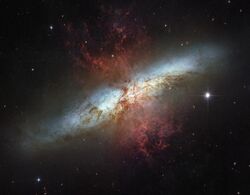
| Arp number | Common name | Description |
|---|---|---|
| 333 | NGC 1024 | |
| 334 | UGC 8498 | |
| 335 | NGC 3509 | |
| 336 | NGC 2685 | |
| 337 | Messier 82 | |
| 338 | PGC 3094767 |
Brightest Arp galaxies for amateur astronomers
Maynard Pittendreigh, an amateur astronomer and occasional writer, has compiled a list of the brightest Arp Galaxies that are most easily viewed by typical amateur astronomers. The galaxies on the list can be observed visually and do not require special photographic or imaging equipment. These include:
See also
- Index Catalogue (IC)
- Messier object (M)
- New General Catalogue (NGC)
- Uppsala General Catalogue (UGC)
Further reading
- J. Kanipe, D. Webb The Arp Atlas of Peculiar Galaxies, A Chronicle and Observer's Guide, Willmann-Bell Inc. (2006) ISBN:978-0-943396-76-7
References
- Atlas of Peculiar Galaxies courtesy of the NASA/IPAC Extragalactic Database. Retrieved on 2006-07-03, 2006-07-12, 2006-07-14, 2006-07-16, 2006-07-17, 2006-07-18, 2006-07-19, 2006-07-20, 2006-07-24, 2006-07-25, 2006-07-26, 2006-07-27, 2006-07-31, 2006-08-02, 2006-08-08, 2006-08-10, 2006-08-13.
- NASA/IPAC Extragalactic Database General information retrieval on individual Arp objects. Retrieved on 2006-07-03, 2006-07-12, 2006-07-14, 2006-07-16, 2006-07-17, 2006-07-18, 2006-07-19, 2006-07-20, 2006-07-24, 2006-07-25, 2006-07-26, 2006-07-27, 2006-07-31, 2006-08-02, 2006-08-08, 2006-08-10, 2006-08-13.
External links
Notes
- ↑ Arp, Halton (1966). Atlas of Peculiar Galaxies. Pasadena, California: California Institute of Technology. http://ned.ipac.caltech.edu/level5/Arp/frames.html. Retrieved 5 Jan 2010. (online version, including Arp's original tabular data, and PDF link)
- ↑ Halton Arp, Seeing Red: Redshift, Cosmology and Academic Science, Aperion, Montreal (August 1998), pp. 14, 61-62, 72, 104-105 ISBN:0-9683689-0-5
- ↑ 3.0 3.1 "NASA/IPAC Extragalactic Database". Results for NGC 2857. http://nedwww.ipac.caltech.edu/.
- ↑ 4.00 4.01 4.02 4.03 4.04 4.05 4.06 4.07 4.08 4.09 4.10 4.11 4.12 4.13 A. Sandage, J. Bedke (1994). Carnegie Atlas of Galaxies. Washington, D.C.: Carnegie Institution of Washington. ISBN 0-87279-667-1.
- ↑ 5.0 5.1 "NASA/IPAC Extragalactic Database". Results for NGC 6365. http://nedwww.ipac.caltech.edu/.
- ↑ "NASA/IPAC Extragalactic Database". Results for IC 167. http://nedwww.ipac.caltech.edu/.
- ↑ "NASA/IPAC Extragalactic Database". Results for UGC 10770. http://nedwww.ipac.caltech.edu/.
- ↑ "NASA/IPAC Extragalactic Database". Results for Arp 45. http://nedwww.ipac.caltech.edu/.
- ↑ "NASA/IPAC Extragalactic Database". Results for Arp 99. http://nedwww.ipac.caltech.edu/.
- ↑ "NASA/IPAC Extragalactic Database". Results for Arp 103. http://nedwww.ipac.caltech.edu/.
- ↑ "NASA/IPAC Extragalactic Database". Results for Arp 111. http://nedwww.ipac.caltech.edu/.
- ↑ "NASA/IPAC Extragalactic Database". Results for NGC 70. http://nedwww.ipac.caltech.edu/.
- ↑ 13.0 13.1 "NASA/IPAC Extragalactic Database". Results for Arp 115. http://nedwww.ipac.caltech.edu/.
- ↑ 14.0 14.1 "NASA/IPAC Extragalactic Database". Results for NGC 2914. http://nedwww.ipac.caltech.edu/.
- ↑ 15.0 15.1 "NASA/IPAC Extragalactic Database". Results for NGC 4015. http://nedwww.ipac.caltech.edu/.
- ↑ 16.0 16.1 R. Lynds, A. Toomre (1976). "On the interpretation of ring galaxies : the binary ring system II Hz4". Astrophysical Journal 209: 328–388. doi:10.1086/154730. Bibcode: 1976ApJ...209..382L.
- ↑ "Hubble spots galaxies in close encounter". ESA/Hubble Press Release. http://www.spacetelescope.org/news/heic1311/.
- ↑ "NASA/IPAC Extragalactic Database". Results for Arp 139. http://nedwww.ipac.caltech.edu/.
- ↑ "NASA/IPAC Extragalactic Database". Results for Arp 140. http://nedwww.ipac.caltech.edu/.
- ↑ "NASA/IPAC Extragalactic Database". Results for Arp 141. http://nedwww.ipac.caltech.edu/.
- ↑ "NASA/IPAC Extragalactic Database". Results for Arp 142. http://nedwww.ipac.caltech.edu/.
- ↑ "NASA/IPAC Extragalactic Database". Results for Arp 143. http://nedwww.ipac.caltech.edu/.
- ↑ "NASA/IPAC Extragalactic Database". Results for Arp 144. http://nedwww.ipac.caltech.edu/.
- ↑ "NASA/IPAC Extragalactic Database". Results for Arp 145. http://nedwww.ipac.caltech.edu/.
- ↑ 25.0 25.1 "NASA/IPAC Extragalactic Database". Results for Arp 151. http://nedwww.ipac.caltech.edu/.
- ↑ 26.0 26.1 "NASA/IPAC Extragalactic Database". Results for M87. http://nedwww.ipac.caltech.edu/.
- ↑ "NASA/IPAC Extragalactic Database". Results for IC 803. http://nedwww.ipac.caltech.edu/.
- ↑ "NASA/IPAC Extragalactic Database". Results for NGC 7609. http://nedwww.ipac.caltech.edu/.
- ↑ 29.0 29.1 "NASA/IPAC Extragalactic Database". Results for NGC 4747. http://nedwww.ipac.caltech.edu/.
- ↑ 30.0 30.1 "NASA/IPAC Extragalactic Database". Results for NGC 5128. http://nedwww.ipac.caltech.edu/.
- ↑ 31.0 31.1 "NASA/IPAC Extragalactic Database". Results for NGC 4670. http://nedwww.ipac.caltech.edu/.
- ↑ "NASA/IPAC Extragalactic Database". Results for Arp 169. http://nedwww.ipac.caltech.edu/.
- ↑ "NASA/IPAC Extragalactic Database". Results for Arp 175. http://nedwww.ipac.caltech.edu/.
- ↑ "NASA/IPAC Extragalactic Database". Results for Arp 176. http://nedwww.ipac.caltech.edu/.
- ↑ "NASA/IPAC Extragalactic Database". Results for Arp 178. http://nedwww.ipac.caltech.edu/.
- ↑ "NASA/IPAC Extragalactic Database". Results for Arp 180. http://nedwww.ipac.caltech.edu/.
- ↑ "NASA/IPAC Extragalactic Database". Results for Arp 181. http://nedwww.ipac.caltech.edu/.
- ↑ "NASA/IPAC Extragalactic Database". Results for Arp 182. http://nedwww.ipac.caltech.edu/.
- ↑ "NASA/IPAC Extragalactic Database". Results for UGC 8560. http://nedwww.ipac.caltech.edu/.
- ↑ "NASA/IPAC Extragalactic Database". Results for NGC 1961. http://nedwww.ipac.caltech.edu/.
- ↑ "NASA/IPAC Extragalactic Database". Results for NGC 6217. http://nedwww.ipac.caltech.edu/.
- ↑ "NASA/IPAC Extragalactic Database". Results for NGC 1614. http://nedwww.ipac.caltech.edu/.
- ↑ "NGC 4651: The Umbrella Galaxy". Astronomy Picture of the Day. http://apod.nasa.gov/apod/ap100415.html.
- ↑ "NASA/IPAC Extragalactic Database". Results for UGC 2320. http://nedwww.ipac.caltech.edu/.
- ↑ "NASA/IPAC Extragalactic Database". Results for UGC 6175. http://nedwww.ipac.caltech.edu/.
- ↑ "NASA/IPAC Extragalactic Database". Results for NGC3303. http://nedwww.ipac.caltech.edu/.
- ↑ 47.0 47.1 "NASA/IPAC Extragalactic Database". Results for NGC 3712. http://nedwww.ipac.caltech.edu/.
- ↑ "NASA/IPAC Extragalactic Database". Results for Arp 194. http://nedwww.ipac.caltech.edu/.
- ↑ "NASA/IPAC Extragalactic Database". Results for Arp 195. http://nedwww.ipac.caltech.edu/.
- ↑ "NASA/IPAC Extragalactic Database". Results for Arp 196. http://nedwww.ipac.caltech.edu/.
- ↑ "NASA/IPAC Extragalactic Database". Results for Arp 197. http://nedwww.ipac.caltech.edu/.
- ↑ "NASA/IPAC Extragalactic Database". Results for Arp 198. http://nedwww.ipac.caltech.edu/.
- ↑ "NASA/IPAC Extragalactic Database". Results for Arp 199. http://nedwww.ipac.caltech.edu/.
- ↑ "NASA/IPAC Extragalactic Database". Results for NGC 1134. http://nedwww.ipac.caltech.edu/.
- ↑ "NASA/IPAC Extragalactic Database". Results for Arp 201. http://nedwww.ipac.caltech.edu/.
- ↑ "NASA/IPAC Extragalactic Database". Results for Arp 202. http://nedwww.ipac.caltech.edu/.
- ↑ "NASA/IPAC Extragalactic Database". Results for Arp 204. http://nedwww.ipac.caltech.edu/.
- ↑ "NASA/IPAC Extragalactic Database". Results for Arp 205. http://nedwww.ipac.caltech.edu/.
- ↑ "NASA/IPAC Extragalactic Database". Results for Arp 206. http://nedwww.ipac.caltech.edu/.
- ↑ "NASA/IPAC Extragalactic Database". Results for Arp 207. http://nedwww.ipac.caltech.edu/.
- ↑ "NASA/IPAC Extragalactic Database". Results for Arp 208. http://nedwww.ipac.caltech.edu/.
- ↑ "NASA/IPAC Extragalactic Database". Results for Arp 209. http://nedwww.ipac.caltech.edu/.
- ↑ "NASA/IPAC Extragalactic Database". Results for NGC 1569. http://nedwww.ipac.caltech.edu/.
- ↑ "NASA/IPAC Extragalactic Database". Results for UGCA 290. http://nedwww.ipac.caltech.edu/.
- ↑ "NASA/IPAC Extragalactic Database". Results for NGC 7625. http://nedwww.ipac.caltech.edu/.
- ↑ "NASA/IPAC Extragalactic Database". Results for IC 356. http://nedwww.ipac.caltech.edu/.
- ↑ "NASA/IPAC Extragalactic Database". Results for NGC 3718. http://nedwww.ipac.caltech.edu/.
- ↑ "NASA/IPAC Extragalactic Database". Results for Arp 216. http://nedwww.ipac.caltech.edu/.
- ↑ "NASA/IPAC Extragalactic Database". Results for NGC 3310. http://nedwww.ipac.caltech.edu/.
- ↑ "NASA/IPAC Extragalactic Database". Results for Arp 218. http://nedwww.ipac.caltech.edu/.
- ↑ "NASA/IPAC Extragalactic Database". Results for Arp 219. http://nedwww.ipac.caltech.edu/.
- ↑ "NASA/IPAC Extragalactic Database". Results for Arp 221. http://nedwww.ipac.caltech.edu/.
- ↑ "NASA/IPAC Extragalactic Database". Results for Arp 227. http://nedwww.ipac.caltech.edu/.
- ↑ "NASA/IPAC Extragalactic Database". Results for IC 162. http://nedwww.ipac.caltech.edu/.
- ↑ "NASA/IPAC Extragalactic Database". Results for Arp 229. http://nedwww.ipac.caltech.edu/.
- ↑ "NASA/IPAC Extragalactic Database". Results for IC 51. http://nedwww.ipac.caltech.edu/.
- ↑ "NASA/IPAC Extragalactic Database". Results for NGC 2911. http://nedwww.ipac.caltech.edu/.
- ↑ "NASA/IPAC Extragalactic Database". Results for UGC 5720. http://nedwww.ipac.caltech.edu/.
- ↑ "NASA/IPAC Extragalactic Database". Results for NGC 3738. http://nedwww.ipac.caltech.edu/.
- ↑ "NASA/IPAC Extragalactic Database". Results for NGC 14. http://nedwww.ipac.caltech.edu/.
- ↑ "NASA/IPAC Extragalactic Database". Results for IC 1623. http://nedwww.ipac.caltech.edu/.
- ↑ "NASA/IPAC Extragalactic Database". Results for UGC 5044. http://nedwww.ipac.caltech.edu/.
- ↑ "NASA/IPAC Extragalactic Database". Results for UGC 8355. http://nedwww.ipac.caltech.edu/.
- ↑ "NASA/IPAC Extragalactic Database". Results for Arp 239. http://nedwww.ipac.caltech.edu/.
- ↑ "NASA/IPAC Extragalactic Database". Results for Arp 240. http://nedwww.ipac.caltech.edu/.
- ↑ "NASA/IPAC Extragalactic Database". Results for UGC 9425. http://nedwww.ipac.caltech.edu/.
- ↑ "NASA/IPAC Extragalactic Database". Results for NGC 4676. http://nedwww.ipac.caltech.edu/.
- ↑ "NASA/IPAC Extragalactic Database". Results for NGC 2623. http://nedwww.ipac.caltech.edu/.
- ↑ "NASA/IPAC Extragalactic Database". Results for Arp 244. http://nedwww.ipac.caltech.edu/.
- ↑ "NASA/IPAC Extragalactic Database". Results for Arp 245. http://nedwww.ipac.caltech.edu/.
- ↑ "NASA/IPAC Extragalactic Database". Results for Arp 246. http://nedwww.ipac.caltech.edu/.
- ↑ "NASA/IPAC Extragalactic Database". Results for UGC 4383. http://nedwww.ipac.caltech.edu/.
- ↑ "NASA/IPAC Extragalactic Database". Results for Arp 248. http://nedwww.ipac.caltech.edu/.
- ↑ "NASA/IPAC Extragalactic Database". Results for UGC 12891. http://nedwww.ipac.caltech.edu/.
- ↑ "NASA/IPAC Extragalactic Database". Results for Arp 251. http://nedwww.ipac.caltech.edu/.
- ↑ "NASA/IPAC Extragalactic Database". Results for Arp 252. http://nedwww.ipac.caltech.edu/.
- ↑ "NASA/IPAC Extragalactic Database". Results for Arp 253. http://nedwww.ipac.caltech.edu/.
- ↑ "NASA/IPAC Extragalactic Database". Results for NGC 5917. http://nedwww.ipac.caltech.edu/.
- ↑ "NASA/IPAC Extragalactic Database". Results for UGC 5304. http://nedwww.ipac.caltech.edu/.
- ↑ "NASA/IPAC Extragalactic Database". Results for Arp 256. http://nedwww.ipac.caltech.edu/.
- ↑ "NASA/IPAC Extragalactic Database". Results for UGC 4836. http://nedwww.ipac.caltech.edu/.
- ↑ "NASA/IPAC Extragalactic Database". Results for UGC 2140. http://nedwww.ipac.caltech.edu/.
- ↑ "NASA/IPAC Extragalactic Database". Results for NGC 7140. http://nedwww.ipac.caltech.edu/.
- ↑ "NASA/IPAC Extragalactic Database". Results for UGC 7230. http://nedwww.ipac.caltech.edu/.
- ↑ "NASA/IPAC Extragalactic Database". Results for Arp 261. http://nedwww.ipac.caltech.edu/.
- ↑ "NASA/IPAC Extragalactic Database". Results for Arp 262. http://nedwww.ipac.caltech.edu/.
- ↑ "NASA/IPAC Extragalactic Database". Results for NGC 3239. http://nedwww.ipac.caltech.edu/.
- ↑ "NASA/IPAC Extragalactic Database". Results for NGC 3104. http://nedwww.ipac.caltech.edu/.
- ↑ "NASA/IPAC Extragalactic Database". Results for IC 3862. http://nedwww.ipac.caltech.edu/.
- ↑ "NASA/IPAC Extragalactic Database". Results for NGC 4861. http://nedwww.ipac.caltech.edu/.
- ↑ "NASA/IPAC Extragalactic Database". Results for UGC 5746. http://nedwww.ipac.caltech.edu/.
- ↑ "NASA/IPAC Extragalactic Database". Results for UGC 4305. http://nedwww.ipac.caltech.edu/.
- ↑ 113.0 113.1 "NASA/IPAC Extragalactic Database". Results for NGC 5679. http://nedwww.ipac.caltech.edu/.
- ↑ "NASA/IPAC Extragalactic Database". Results for Arp 269. http://nedwww.ipac.caltech.edu/.
- ↑ "NASA/IPAC Extragalactic Database". Results for Arp 270. http://nedwww.ipac.caltech.edu/.
- ↑ "NASA/IPAC Extragalactic Database". Results for Arp 271. http://nedwww.ipac.caltech.edu/.
- ↑ "NASA/IPAC Extragalactic Database". Results for UGC 10186. http://nedwww.ipac.caltech.edu/.
- ↑ "NASA/IPAC Extragalactic Database". Results for Arp 273. http://nedwww.ipac.caltech.edu/.
- ↑ "NASA/IPAC Extragalactic Database". Results for NGC 2881. http://nedwww.ipac.caltech.edu/.
- ↑ "NASA/IPAC Extragalactic Database". Results for Arp 276. http://nedwww.ipac.caltech.edu/.
- ↑ "NASA/IPAC Extragalactic Database". Results for Arp 277. http://nedwww.ipac.caltech.edu/.
- ↑ "NASA/IPAC Extragalactic Database". Results for NGC 7253. http://nedwww.ipac.caltech.edu/.
- ↑ "NASA/IPAC Extragalactic Database". Results for Arp 279. http://nedwww.ipac.caltech.edu/.
- ↑ "NASA/IPAC Extragalactic Database". Results for Arp 280. http://nedwww.ipac.caltech.edu/.
- ↑ "NASA/IPAC Extragalactic Database". Results for Arp 281. http://nedwww.ipac.caltech.edu/.
- ↑ "NASA/IPAC Extragalactic Database". Results for Arp 282. http://nedwww.ipac.caltech.edu/.
- ↑ "NASA/IPAC Extragalactic Database". Results for Arp 283. http://nedwww.ipac.caltech.edu/.
- ↑ "NASA/IPAC Extragalactic Database". Results for Arp 284. http://nedwww.ipac.caltech.edu/.
- ↑ "NASA/IPAC Extragalactic Database". Results for Arp 285. http://nedwww.ipac.caltech.edu/.
- ↑ Nemiroff, R.; Bonnell, J., eds (13 August 2010). "Arp 286: Trio in Virgo". Astronomy Picture of the Day. NASA. https://apod.nasa.gov/apod/ap100813.html.
- ↑ "NASA/IPAC Extragalactic Database". Results for Arp 287. http://nedwww.ipac.caltech.edu/.
- ↑ "NASA/IPAC Extragalactic Database". Results for Arp 288. http://nedwww.ipac.caltech.edu/.
- ↑ "NASA/IPAC Extragalactic Database". Results for NGC 3981. http://nedwww.ipac.caltech.edu/.
- ↑ "NASA/IPAC Extragalactic Database". Results for Arp 290. http://nedwww.ipac.caltech.edu/.
- ↑ "NASA/IPAC Extragalactic Database". Results for UGC 5832. http://nedwww.ipac.caltech.edu/.
- ↑ "NASA/IPAC Extragalactic Database". Results for IC 575. http://nedwww.ipac.caltech.edu/.
- ↑ "NASA/IPAC Extragalactic Database". Results for Arp 293. http://nedwww.ipac.caltech.edu/.
- ↑ "NASA/IPAC Extragalactic Database". Results for Arp 294. http://nedwww.ipac.caltech.edu/.
- ↑ "NASA/IPAC Extragalactic Database". Results for Arp 295. http://nedwww.ipac.caltech.edu/.
- ↑ "NASA/IPAC Extragalactic Database". Results for Arp 297. http://nedwww.ipac.caltech.edu/.
- ↑ "NASA/IPAC Extragalactic Database". Results for Arp 298. http://nedwww.ipac.caltech.edu/.
- ↑ "NASA/IPAC Extragalactic Database". Results for Arp 299. http://nedwww.ipac.caltech.edu/.
- ↑ "NASA/IPAC Extragalactic Database". Results for Arp 300. http://nedwww.ipac.caltech.edu/.
- ↑ "NASA/IPAC Extragalactic Database". Results for Arp 301. http://nedwww.ipac.caltech.edu/.
- ↑ "NASA/IPAC Extragalactic Database". Results for UGC 9618. http://nedwww.ipac.caltech.edu/.
- ↑ "NASA/IPAC Extragalactic Database". Results for Arp 303. http://nedwww.ipac.caltech.edu/.
- ↑ "NASA/IPAC Extragalactic Database". Results for Arp 304. http://nedwww.ipac.caltech.edu/.
- ↑ "NASA/IPAC Extragalactic Database". Results for Arp 305. http://nedwww.ipac.caltech.edu/.
- ↑ "NASA/IPAC Extragalactic Database". Results for Arp 306. http://nedwww.ipac.caltech.edu/.
- ↑ "NASA/IPAC Extragalactic Database". Results for Arp 307. http://nedwww.ipac.caltech.edu/.
- ↑ "NASA/IPAC Extragalactic Database". Results for Arp 308. http://nedwww.ipac.caltech.edu/.
- ↑ "NASA/IPAC Extragalactic Database". Results for Arp 309. http://nedwww.ipac.caltech.edu/.
- ↑ "NASA/IPAC Extragalactic Database". Results for Arp 310. http://nedwww.ipac.caltech.edu/.
 |
 KSF
KSF

